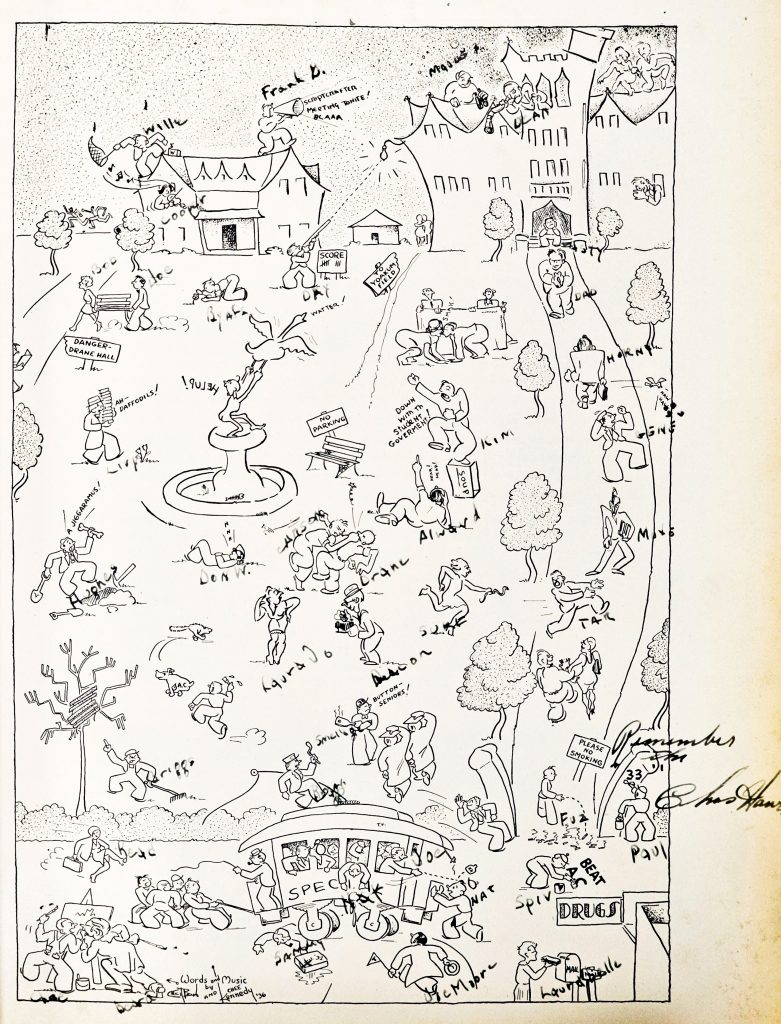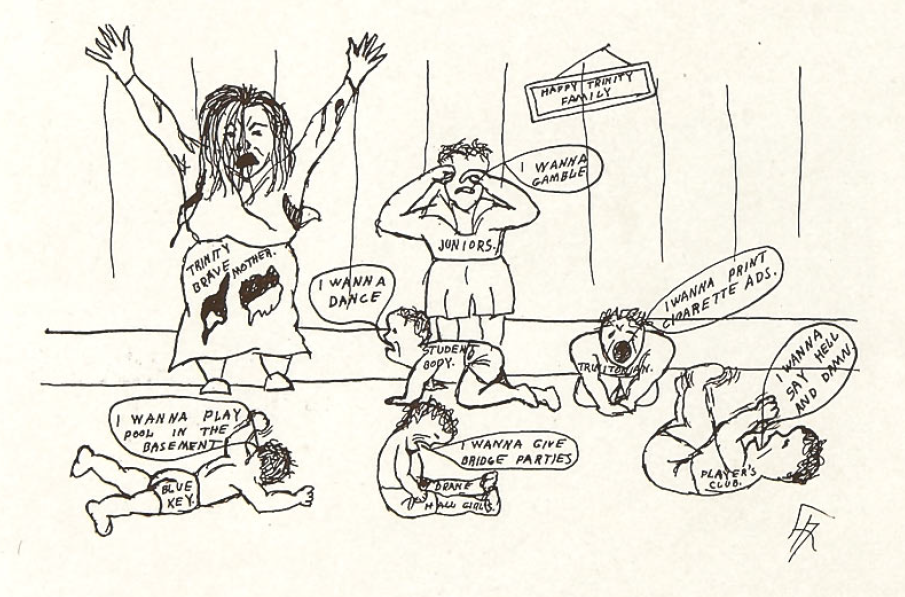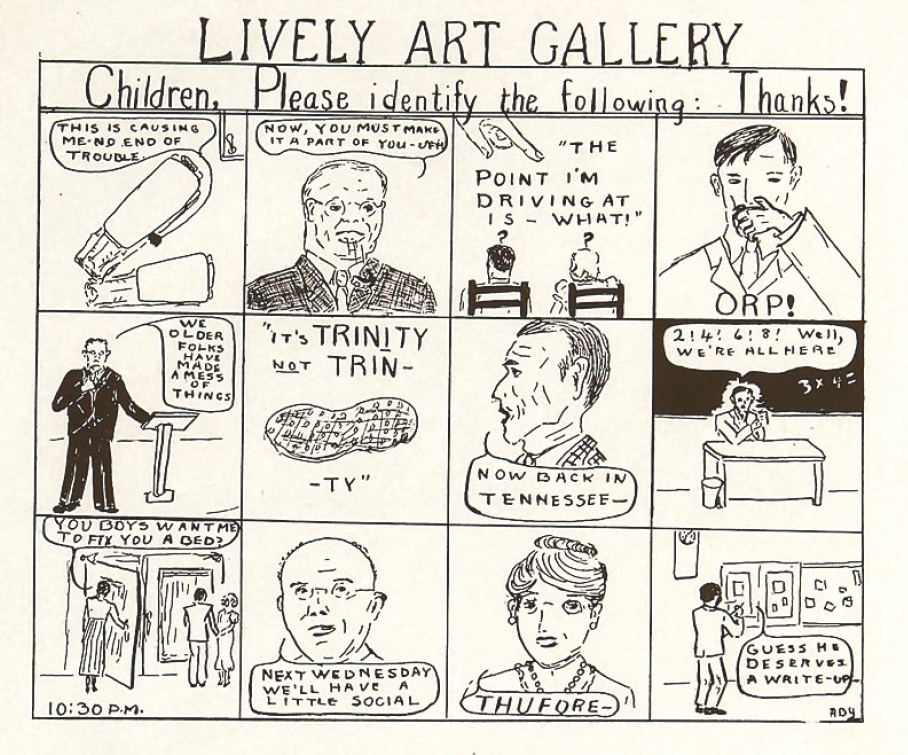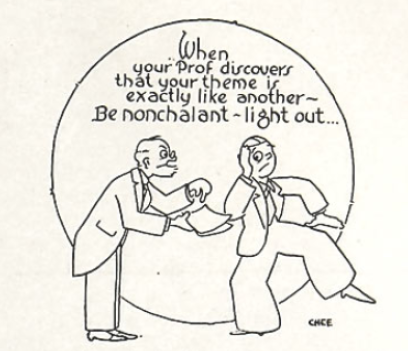Coming to Trinity…95 years ago
Nestled in the John H. Burma Jr. Papers is a personal 1930 copy of Trinity’s yearbook, Mirage. Evidenced by dozens of handwritten messages, Burma Jr. was an active, well-liked freshman who balanced the usual complexities of academic and social life… but as the university president’s son. Despite this, Burma made the most out of his freshman year and remained remarkably involved, forming friendships across classes and attending games.
On a campus scene drawn by students Lee A. Kennedy and Cecil Beard, Burma labeled nearly every individual, giving a glimpse into the personalities of his peers, professors, and father. The deans watch with their spyglasses, while Rev. John H. Burma Sr. can be seen with his eyes closed, hands clasped as he wades through what the yearbook describes as “a spirit of restlessness.” The student body was keenly aware of the administration’s troubles with this spirit, and poignantly prefaced that “no great soul is tranquil.”

Cecil Beard later worked at Disney’s studio, animating on pioneering works such as Snow White, Pinocchio, and Bambi. From the Mirage 1930, p. 131.
Burma witnessed these words actively shape his experience at Trinity for the rest of his undergraduate years. Through persistent student calls for dances among other activities, the classes of the early 1930s saw some of the most considerable shifts, both within and outside campus. A severe economic downtrend loomed above the nation, fueling uncertainty. Yet, it also deepened solidarity amongst students, faculty, and the larger community, as a means to push through difficult times.

From the Mirage 1933, p. 88.
In 1932 they successfully applied enough pressure on administration to host a faculty-monitored dance, but for the next several years wrestled with numerous overturns. Eventually, the issue of dancing became less pressing, against the backdrop of the Great Depression and declining college enrollment rates across the country (Trinity University: A Tale of Three Cities, p. 131-132).

A comic that could pass as being from a 2000s Indie movie. From the Mirage 1933, p. 89.
Although the depictions are largely playful, they are just as humanizing. Without Burma labeling the large campus scene, viewers wouldn’t be able to easily identify the figures. His notes on faculty and cheeky messages from upperclassmen illustrate more than just portraits of the past, but capture relationships in action. While there may be several copies of yearbooks for any given year, individual copies contain the relationships between certain students, the campus, and the world. In the same way, the Mirages’ unfiltered comics allow readers to obtain a greater sense of what it was like to be a part of their “restless spirit,” and how timeless the past can be (or conversely, how gravely dated). Behind the humor was a genuine appreciation for the faculty and staff, who supported the students in capacities far beyond academic duty; the 1930 Mirage begins with a dedication to a faculty member. Collections like Burma’s are not only invaluable gifts to researchers, but anyone interested in the human experience itself, including their own within.

Dr. Samuel Hornbeak (left), professor and former university president, earned several notes from Burma Jr. and comic appearances. From the Mirage 1930, p. 137.
Burma Sr. retired as president of the university in 1933 as his son completed his degree, and Burma Jr. continued studying sociology all the way to the PhD level. As both a published author and professor, he dedicated his career to higher education and taught sociology, anthropology, and criminology. Yearbooks from the John H. Burma Jr. Papers and other years can be accessed at the University Archives in the Coates Library.
This post is brought to you by Sierra Withers, archives associate, who recently processed the John H. Burma Jr. Papers.